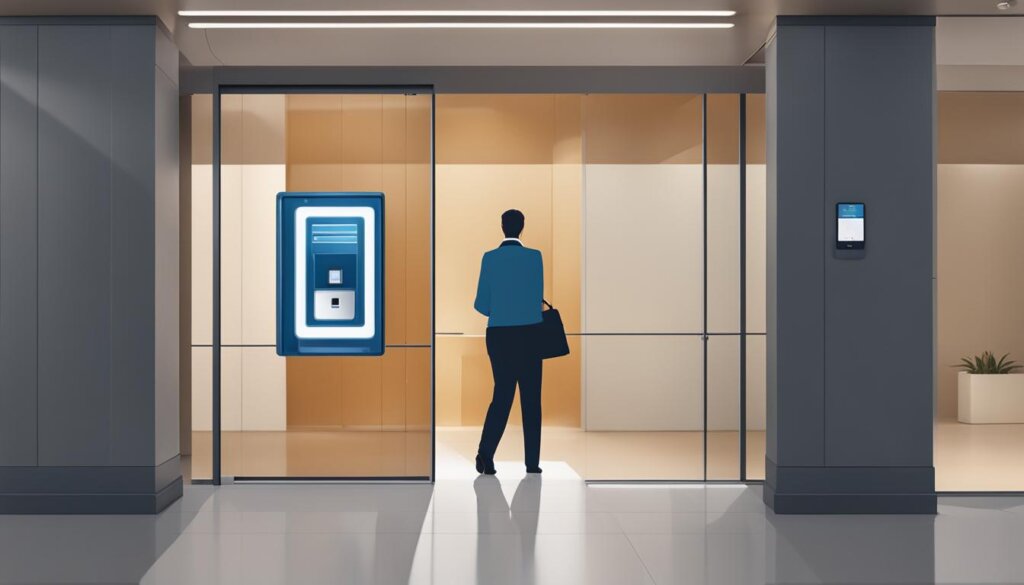Table of Contents
Access control is a vital method for restricting access to sensitive data. It plays a crucial role in ensuring the security of physical assets and protecting computer systems and networks from unauthorized access.
There are two main types of access control: physical access control and logical access control. Physical access control limits access to campuses, buildings, and other physical assets, while logical access control restricts access to computers, networks, files, and sensitive data.
Components of access control include authentication, authorization, access, management, and audit. Authentication involves verifying the identity of individuals or system users through various means such as biometrics, passwords, or PINs. Authorization determines the access rights or privileges of authenticated individuals or systems.
Access control management involves adding and removing authentication and authorization for users or systems. Audit ensures regular review and monitoring of access to minimize the risk of users having access they no longer need.
By implementing access control measures, organizations can minimize the risk of unauthorized access, adhere to regulatory requirements, and protect sensitive data from potential data breaches.
Components of Access Control
In order to effectively implement access control measures, it is important to understand the five main components of this security practice. These components include authentication, authorization, access, management, and audit.
- Authentication: This component involves the verification of an individual’s or system’s identity. Different means of authentication may be used, such as personal identity documents, digital certificates, or login credentials. The goal is to ensure that only authorized individuals or systems can gain access to sensitive resources.
- Authorization: Once the authentication process is complete, the authorization component determines the access rights or privileges of the authenticated entity. It establishes what actions or resources the individual or system is allowed to access.
- Access: Access is granted to the authenticated and authorized entity after the completion of the authentication and authorization processes. This component allows the individual or system to interact with the desired resources or perform specific actions.
- Management: The management component of access control involves the administration of authentication and authorization. It includes tasks such as adding or removing users or systems, assigning access privileges, and synchronizing authentication and authorization with directory services like G Suite or Azure Active Directory.
- Audit: To ensure the security and integrity of access control measures, the audit component plays a crucial role. It involves the regular review and monitoring of access activities to detect any unauthorized or suspicious behavior. By enforcing the principle of least privilege, audit helps minimize the risk of users having access they no longer need.
Understanding and implementing these components is essential for maintaining the confidentiality, integrity, and availability of sensitive data and resources.
How Access Control Works
Access control is a fundamental aspect of safeguarding sensitive information and physical assets. It encompasses two main categories: physical access control and logical access control.
Physical access control involves restricting entry to campuses, buildings, and other tangible resources. This type of access control typically employs various methods, such as:
- Proximity cards
- Biometrics
Logical access control, on the other hand, is concerned with limiting access to computer systems, networks, files, and confidential data. Different authentication methods are employed in logical access control systems, including:
- Biometrics
- Key fobs
- Passwords
- PINs
Access control software functions by identifying individuals, verifying their identity, authorizing their access level, and keeping a detailed record of their actions for auditing purposes.

Effective access control measures are crucial for protecting physical assets, sensitive data, and maintaining regulatory compliance. By employing both physical and logical access control methods, organizations can ensure comprehensive security for their resources and systems.
Types of Access Control
Access control plays a vital role in protecting sensitive data and resources from unauthorized access. There are several types of access control mechanisms that organizations employ to ensure data security and maintain control over their assets:
Attribute-Based Access Control (ABAC): ABAC is a dynamic and flexible access control model that grants access to resources based on attributes and claims. It allows organizations to create detailed access policies that consider various factors such as user attributes, resource attributes, and environmental conditions.
Discretionary Access Control (DAC): DAC is a widely used access control model that relies on resource owners to determine and enforce access policies. With DAC, individuals or groups are granted access permissions based on their relationship to the resource and the discretion of the owner.
Mandatory Access Control (MAC): MAC is a stringent access control model that regulates access rights based on security levels and clearances. It is commonly used in environments where data confidentiality is of utmost importance, such as military or government organizations.
Role-Based Access Control (RBAC): RBAC grants access based on predefined user roles rather than individual ownership. This model simplifies access management by assigning permissions and privileges to specific roles, allowing for efficient administration and reducing the risk of unauthorized access.
Different types of access control systems offer varying levels of security, flexibility, and ease of management. Organizations should carefully evaluate their specific needs and requirements to determine the most appropriate access control model for their environment.
FAQ
What is access control?
Access control is a method of restricting access to sensitive data. It involves the authentication, authorization, access, management, and audit of individuals or systems.
What are the two main types of access control?
The two main types of access control are physical access control, which limits access to physical assets, and logical access control, which restricts access to computers, networks, and sensitive data.
Why is access control important?
Access control is important for minimizing the risk of unauthorized access to physical and computer systems, ensuring regulatory compliance, and protecting against data breaches.
What are the components of access control?
The five main components of access control are authentication, authorization, access, management, and audit.
What is authentication in access control?
Authentication involves proving the identity of a person or computer user through various means such as personal identity documents, digital certificates, or login credentials.
What is authorization in access control?
Authorization determines the access rights or privileges of an authenticated individual or system.
How is access granted in access control?
Access is granted once authentication and authorization have been completed.
What is management in access control?
Management involves adding and removing authentication and authorization of users or systems, often through the use of synchronization with directory services like G Suite or Azure Active Directory.
What is audit in access control?
Audit is used to enforce the principle of least privilege by regularly reviewing and monitoring access to minimize the risk of users having access they no longer need.
What is physical access control?
Physical access control limits access to campuses, buildings, and other physical assets.
What is logical access control?
Logical access control restricts access to computers, networks, files, and sensitive data.
What are the authentication methods used in access control systems?
Authentication methods used in access control systems can include biometrics, key fobs, passwords, or PINs.
How does access control software work?
Access control software works by identifying an individual, verifying their identity, authorizing their access level, and storing their actions for auditing purposes.
What are the types of access control?
The types of access control include attribute-based access control (ABAC), discretionary access control (DAC), mandatory access control (MAC), role-based access control (RBAC), rule-based access control, and break-glass access control.
What is attribute-based access control (ABAC)?
ABAC grants access based on attributes and claims.
What is discretionary access control (DAC)?
DAC relies on resource owners to set access policies.
What is mandatory access control (MAC)?
MAC regulates access rights based on security levels and clearances.
What is role-based access control (RBAC)?
RBAC determines access based on user roles rather than ownership.
What is rule-based access control?
Rule-based access control defines access rules based on conditions.
What is break-glass access control?
Break-glass access control allows temporary access overrides for critical situations.













